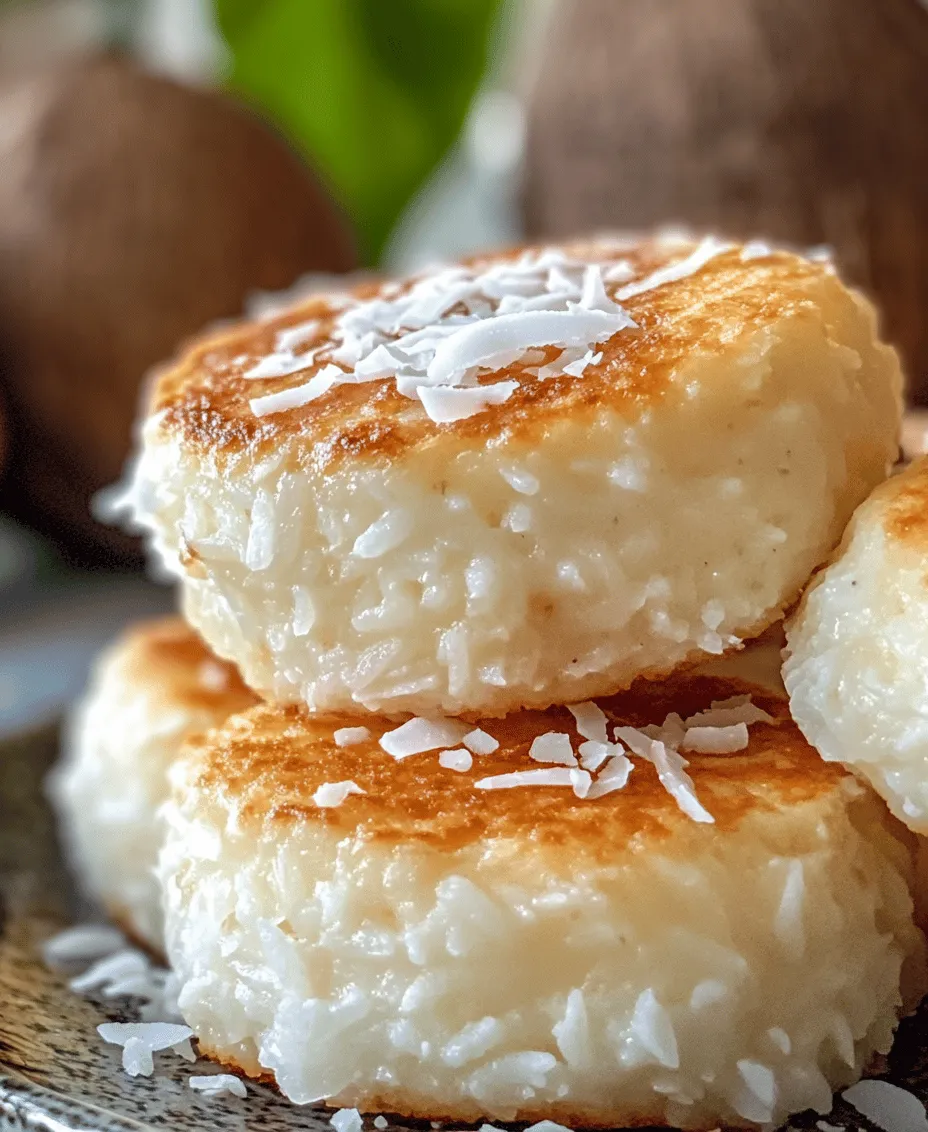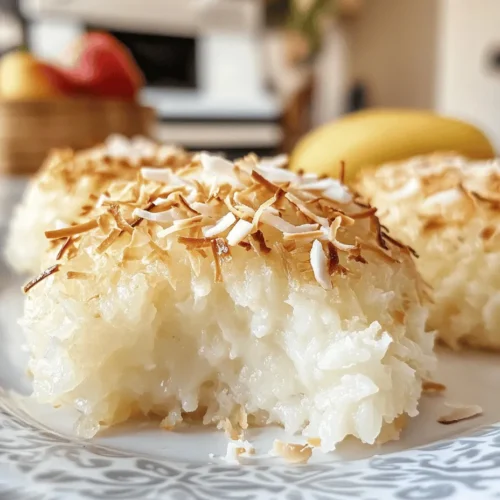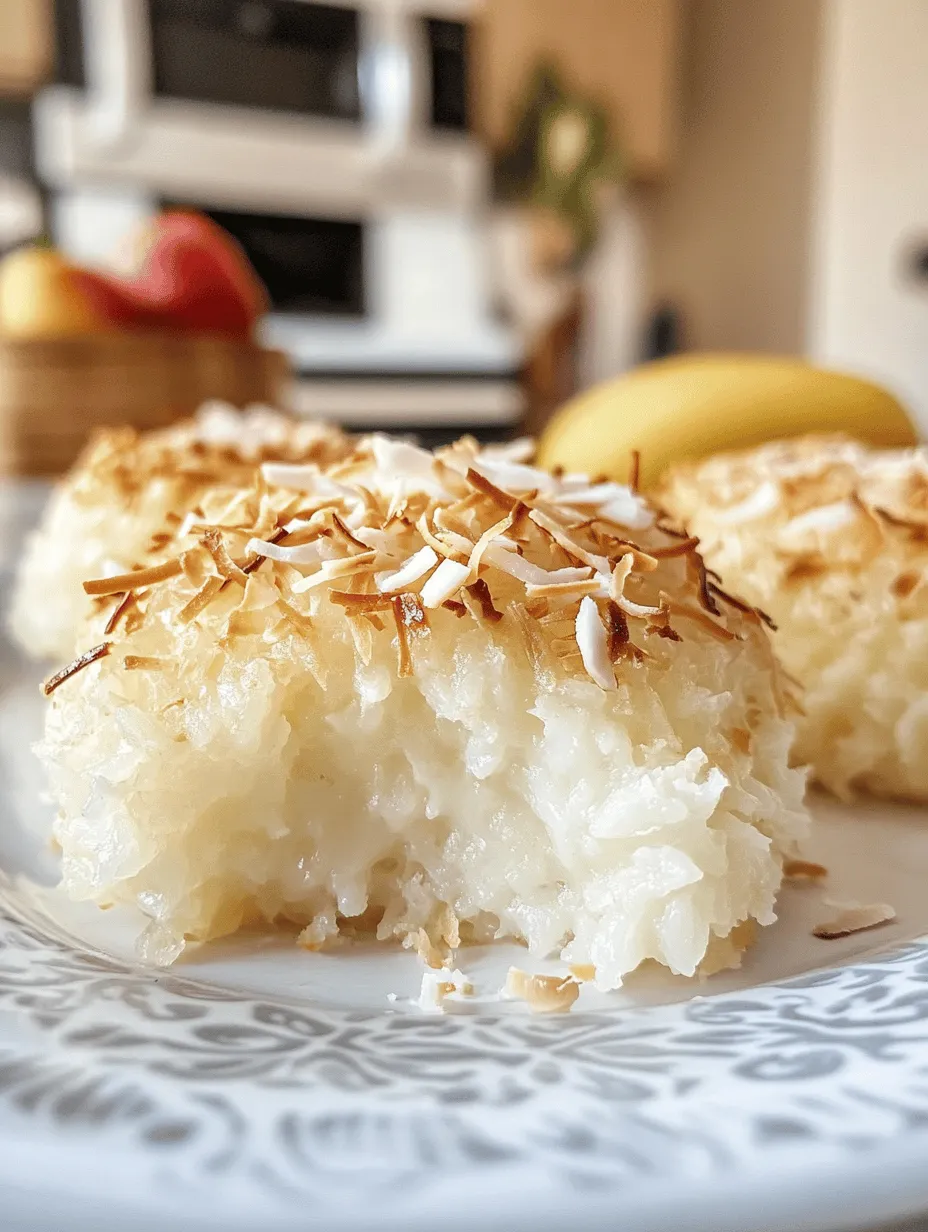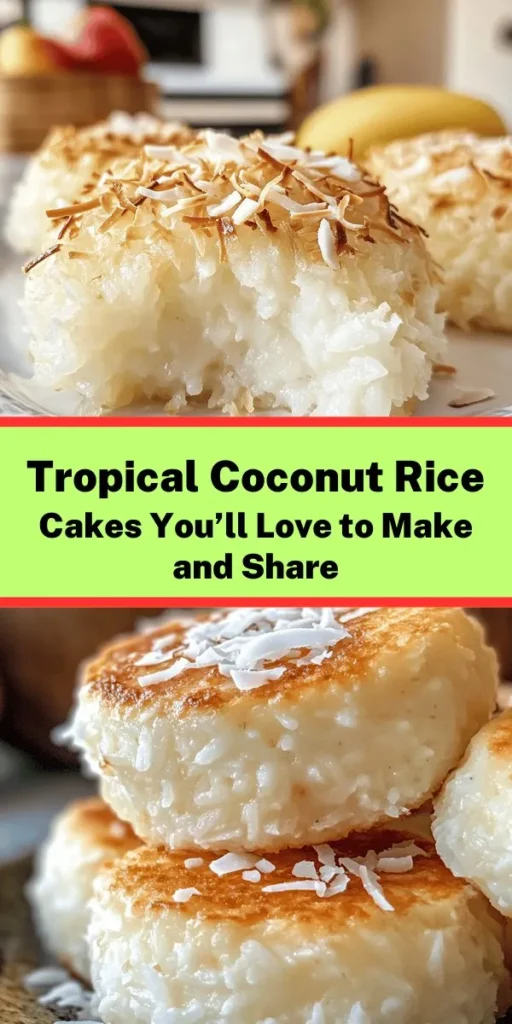Introduction
When it comes to desserts that evoke a sense of paradise, few can compete with the allure of tropical-inspired treats. Among these, coconut rice cakes stand out as a delectable option that combines the rich, creamy essence of coconut with the comforting texture of rice. These delightful morsels are not only a feast for the eyes but also a celebration of flavors that transport you straight to sun-kissed beaches and swaying palm trees.
Coconut is a versatile ingredient that graces both sweet and savory dishes across various cuisines. Its unique flavor profile adds a hint of sweetness and a rich creaminess that enhances any dish it touches. Whether it’s the star of a refreshing piña colada or a supporting player in a savory curry, coconut has a way of elevating culinary experiences. In this article, we will delve into the world of coconut rice cakes, exploring their cultural significance, flavor, and texture, while guiding you through a simple yet rewarding recipe.
Understanding Coconut Rice Cakes
Coconut rice cakes are a delightful dessert that showcases the beautiful harmony between rice and coconut. These cakes are typically made with glutinous or jasmine rice, which provides a soft, chewy texture that is comforting and satisfying. The addition of coconut milk brings a luscious creaminess that pairs perfectly with the delicate sweetness of the rice.
Coconut rice cakes hold a special place in various cuisines around the world, from Southeast Asian dishes to Caribbean delights. In places like Thailand, coconut rice cakes are often served as a festive treat during celebrations, while in the Caribbean, they can be found as a popular street food. Their versatility makes them suitable for different occasions, whether you’re serving them at a summer barbecue, a holiday gathering, or simply enjoying them as a sweet snack with your afternoon tea.
The appeal of these coconut rice cakes lies not only in their delightful flavor but also in their adaptability. They can be enjoyed plain, topped with fresh fruit, drizzled with honey, or even paired with a scoop of ice cream for a decadent dessert. No matter how you choose to enjoy them, coconut rice cakes are sure to impress with their unique taste and texture.
Ingredients Overview
Before we dive into the preparation process, it’s essential to understand the key ingredients that make these coconut rice cakes so irresistible. Each component plays a vital role in achieving the perfect balance of flavor and texture.
Jasmine Rice
Jasmine rice is the star ingredient of this recipe. Known for its aromatic qualities, jasmine rice has a slightly sticky texture when cooked, making it an ideal choice for rice cakes. Its subtle floral notes and nutty flavor enhance the overall taste of the dish, giving it a unique identity. When cooked properly, jasmine rice provides a tender base that beautifully absorbs the creamy coconut milk.
Coconut Milk
Coconut milk is what elevates these rice cakes from ordinary to extraordinary. With its rich and creamy texture, coconut milk imparts a tropical flavor that is both sweet and savory. It not only adds moisture to the rice cakes but also enhances their overall flavor profile. Using full-fat coconut milk will yield the best results, creating a decadent treat that melts in your mouth.
Shredded Coconut
Unsweetened shredded coconut adds an additional layer of texture and flavor to the rice cakes. The chewy strands of coconut provide a delightful contrast to the soft rice, making each bite a joy to savor. It also amplifies the coconut flavor, ensuring that the essence of this tropical fruit shines through in every morsel.
Sugar
While sugar is an optional ingredient in this recipe, it allows you to tailor the sweetness of your coconut rice cakes to your liking. Depending on your personal preference and the natural sweetness of the coconut milk, you can adjust the amount of sugar used. For those who prefer a less sweet treat, you can easily omit the sugar or use a sugar substitute.
Salt and Vanilla Extract
Salt may seem like a small addition, but it plays a crucial role in enhancing the flavors of the dish. A pinch of salt can bring out the natural sweetness of the coconut and rice, making the overall taste more vibrant. Vanilla extract, on the other hand, adds a warm, aromatic note that complements the tropical flavors beautifully.
Baking Powder
Baking powder is essential for giving the coconut rice cakes a light and airy texture. It acts as a leavening agent, helping the cakes rise slightly during baking and preventing them from becoming too dense. This subtle lift is what makes these rice cakes delightfully soft and enjoyable to eat.
Cooking Spray or Oil
Lastly, cooking spray or oil is necessary for greasing the baking dish. This simple step ensures that your coconut rice cakes do not stick to the pan, allowing for easy removal once they are baked to perfection. Using a non-stick spray or a light coating of oil will help to achieve clean edges and a beautiful presentation.
Step-by-Step Preparation Guide
Now that we have explored the ingredients, let’s dive into the step-by-step preparation process for making these irresistible coconut rice cakes. Follow these instructions carefully to ensure that your coconut rice cakes turn out perfectly every time.
Step 1: Rinse the Jasmine Rice
Begin by measuring out 1 cup of jasmine rice. Place the rice in a fine-mesh strainer and rinse it under cold water until the water runs clear. This step is crucial as it removes excess starch from the rice, preventing the cakes from becoming overly sticky. After rinsing, let the rice drain for a few minutes.
Step 2: Cook the Jasmine Rice
In a medium saucepan, combine the rinsed jasmine rice with 1 ½ cups of water. Bring the mixture to a boil over medium-high heat. Once boiling, reduce the heat to low, cover the saucepan with a tight-fitting lid, and let it simmer for about 15 minutes or until the rice is tender and the water has been absorbed. Once cooked, remove the saucepan from the heat and let the rice sit, covered, for an additional 10 minutes. This resting period allows the rice to steam and become fluffy.
Step 3: Prepare the Coconut Mixture
While the rice is resting, prepare the coconut mixture. In a separate mixing bowl, combine 1 cup of coconut milk, ½ cup of shredded coconut, 1 teaspoon of vanilla extract, and a pinch of salt. If you choose to add sugar, this is the time to incorporate it (start with 2 tablespoons and adjust to taste). Whisk the mixture until well combined, ensuring that the shredded coconut is evenly distributed.
Step 4: Combine Rice and Coconut Mixture
Once the rice has rested, fluff it with a fork to separate the grains. Gradually add the coconut mixture to the cooked rice, stirring gently to combine. Make sure the rice is evenly coated with the coconut mixture, ensuring that every grain is infused with that delightful coconut flavor.
Step 5: Prepare the Baking Dish
Preheat your oven to 350°F (175°C). While the oven is heating, prepare an 8×8-inch baking dish by lightly greasing it with cooking spray or oil. This will prevent the coconut rice cakes from sticking to the pan and make for easy removal once baked.
Step 6: Transfer the Mixture to the Baking Dish
Pour the coconut rice mixture into the prepared baking dish, spreading it evenly with a spatula. Press down gently to ensure that the mixture is compact and even. This step is essential for achieving uniform rice cakes that hold their shape during baking.
Step 7: Bake the Rice Cakes
Place the baking dish in the preheated oven and bake for about 30-35 minutes, or until the edges are lightly golden and the center is set. The baking time may vary slightly depending on your oven, so keep an eye on the cakes as they bake. You want a firm texture that still retains a bit of softness in the center.
Step 8: Cool and Slice
Once baked, remove the coconut rice cakes from the oven and allow them to cool in the baking dish for about 10-15 minutes. This cooling time is crucial as it helps the cakes firm up, making them easier to slice. After cooling, use a sharp knife to cut the cakes into squares or rectangles, depending on your preference.
Step 9: Serve and Enjoy
Your tropical coconut rice cakes are now ready to be enjoyed! Serve them warm or at room temperature, and feel free to garnish them with additional shredded coconut, fresh fruit, or a drizzle of honey for added flavor. These cakes are perfect for sharing with friends and family or savoring on your own as a sweet escape to a tropical paradise.
In the next part of this article, we will explore tips for achieving the best results, variations to try, and answers to common questions about coconut rice cakes. Stay tuned for more delightful insights into this tropical dessert!

Rinsing and Soaking the Rice
Rinsing and soaking the rice are crucial steps in preparing coconut rice cakes that greatly affect the final texture and flavor. Rinsing helps remove excess starch from the rice, which can lead to a gummy texture when cooked. Instead, you want each grain to be fluffy and separate. To rinse the rice, place it in a fine-mesh sieve or a bowl, and run cold water over it until the water runs clear. This process usually takes a few minutes and ensures that your rice will have the ideal consistency after cooking.
Soaking the rice is equally important. By soaking the rice for at least 30 minutes, you allow the grains to absorb some water, which promotes even cooking and reduces the overall cooking time. This step is particularly essential for glutinous rice, which is often used in Asian desserts. After soaking, drain the rice well before proceeding to the next step.
Cooking the Rice
Cooking the rice in coconut milk is where the magic happens. The rich, creamy texture of coconut milk infuses the rice with a delightful flavor that is essential for coconut rice cakes. Start by combining the rinsed and soaked rice in a pot with the appropriate amount of coconut milk and water—typically, a 1:1 ratio of coconut milk to water works best, but you can adjust this based on your taste preference for creaminess.
Bring the mixture to a gentle boil over medium heat. Once boiling, reduce the heat to low and cover the pot with a tight-fitting lid. This is important; covering the pot ensures that the steam remains trapped inside, cooking the rice evenly. Allow the rice to simmer for about 18-20 minutes without lifting the lid. When the cooking time is up, turn off the heat and let the rice sit, still covered, for another 10 minutes. This resting period allows the rice to finish cooking in its steam and promotes a fluffy texture.
Mixing Ingredients
Once the rice has rested, it’s time to mix in additional ingredients. The key to achieving a delicious coconut rice cake lies in allowing the rice to cool slightly before adding any sweeteners or flavorings. This cooling period prevents the sugar from melting too quickly, which can lead to a dense mixture.
In a large bowl, gently fluff the cooked rice with a fork to separate any clumps. Then, gradually incorporate your sweetener of choice, whether it’s sugar, honey, or agave syrup. You can also add a pinch of salt to enhance the flavor profile. For an extra layer of taste, consider mixing in ingredients such as vanilla extract or a hint of almond extract. Finally, fold in shredded coconut, which adds texture and enhances the coconut flavor, creating a deliciously aromatic mixture.
Preparing the Baking Dish
Preheating your oven is a vital step in the baking process. Ensure that your oven reaches the required temperature of 350°F (175°C) before placing the baking dish inside. This guarantees even baking and a nice golden crust on your coconut rice cakes.
While the oven is heating, prepare your baking dish. Grease it generously with coconut oil or non-stick cooking spray to prevent the rice cakes from sticking. You can also line the bottom with parchment paper for added insurance. This step is crucial because baked rice cakes can be quite delicate, and a well-greased dish will help maintain their integrity when removing them.
Filling the Dish
When it comes time to fill the baking dish, ensure the mixture is evenly distributed. Spoon the coconut rice mixture into the prepared dish, using a spatula to spread it out into an even layer. This step is essential for uniform baking; if the mixture is uneven, some parts may cook faster than others, resulting in inconsistent textures.
Press the mixture down gently but firmly; this helps compact the rice and ensures that the rice cakes hold their shape once baked. Making sure the surface is level will not only improve the appearance but also contribute to even baking throughout the entire dish.
Baking Process
Place the filled dish in your preheated oven and bake for approximately 30-35 minutes. You’ll know the coconut rice cakes are done when the edges are slightly golden brown, and a toothpick inserted into the center comes out clean. Keep an eye on them as baking times can vary based on your oven and the depth of the mixture in the dish. If they start to brown too quickly, cover the top loosely with aluminum foil to prevent burning.
Cooling and Slicing
Once the baking is complete, remove the dish from the oven and let it cool in the pan for about 10-15 minutes. This cooling time is crucial, as it allows the rice cakes to firm up and makes them easier to slice. After cooling, run a knife around the edges of the dish to loosen the rice cakes. Carefully invert the dish onto a cutting board to release the rice cakes, or simply cut them in the dish if you prefer. Use a sharp knife to slice the cakes into squares or rectangles, ensuring clean edges for an appealing presentation.
Serving Suggestions
Coconut rice cakes are incredibly versatile and can be enjoyed in various ways. For a refreshing contrast, pair them with a fruity salsa made from diced mango, pineapple, or kiwi. A drizzle of coconut milk or a scoop of coconut yogurt can also add a creamy element that complements the cakes beautifully.
For a more indulgent dessert, consider topping the rice cakes with a sprinkle of toasted coconut flakes or a dusting of powdered sugar. They can also be served warm with a side of tropical fruit or as part of a larger dessert platter.
Nutritional Information
Coconut rice cakes offer a delightful blend of flavors and nutrients. The primary ingredient, rice, is a great source of carbohydrates, providing energy for your day. Coconut adds healthy fats and dietary fiber, which can help promote digestion and support heart health. Each serving of these rice cakes can provide a moderate amount of protein and essential vitamins, particularly if you include shredded coconut, which is rich in manganese and copper.
While these rice cakes can be enjoyed as a treat, their ingredients make them a more wholesome option compared to other dessert choices, especially when using natural sweeteners.
Variations and Customizations
The beauty of coconut rice cakes lies in their adaptability. Feel free to customize the recipe by incorporating different fruits, such as diced bananas or berries, which can add both flavor and nutritional value. You can also experiment with spices like cinnamon or nutmeg for added warmth and depth.
If you’re looking for a crunch, consider folding in chopped nuts such as almonds or cashews before baking. To cater to vegan diets, ensure that any sweeteners used are plant-based, and you can substitute regular coconut milk for a non-dairy version if desired.
Cultural Significance of Coconut in Cuisine
Coconut plays a significant role in the culinary traditions of tropical regions around the world. In Southeast Asia, for instance, coconut is a staple ingredient in many desserts, from rich curries to sweet confections like coconut sticky rice. Its versatility allows it to be featured in both sweet and savory dishes, making it a beloved ingredient in many cultures.
In the Caribbean, coconut is often used in cakes and puddings, embodying the vibrant flavors of the islands. The growing popularity of coconut products has also made their way into Western cuisines, with coconut milk and oil becoming household staples. This cross-cultural appeal highlights the coconut’s unique ability to enhance flavors and provide a sense of home, no matter where you are.
Conclusion
Making coconut rice cakes is not just about creating a delicious dessert; it’s about bringing a taste of the tropics into your home kitchen. The process is simple yet satisfying, allowing you to explore a recipe that celebrates flavor and creativity.
As you enjoy these delectable treats, remember to experiment with your variations and presentation styles. Whether you serve them at a gathering or savor them on your own, coconut rice cakes are sure to delight your palate and evoke the warmth of tropical climates. Share your experiences and unique adaptations, and let this recipe inspire your culinary adventures in the kitchen.



